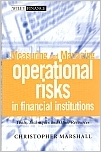| |||||
• polskie
• Zamów informacje o nowościach z wybranego tematu • kontakt |
MEASURING AND MANAGING OPERATIONAL RISK IN FINANCIAL INSTITUTIONMARSHALL C.wydawnictwo: WILEY, 2001, wydanie Icena netto: Measuring and Managing Operational Risk in Financial Institucions Tools Techniques and Other Resources This book is much needed and is a logical extension to what the market has developed in risk management systems so far. Claudia Zeisberger CEO, TTS Asia.com The objective of this book is to develop managers' understanding of the major issues involved in operational risk measurement and management. The book does not specify a single best approach to measuring and managing operational risk exposures. Unlike, say, financial market risks, operational risks are deeply embedded in the contexts of specific businesses, and therefore, simplistic globally prescriptive approaches are inappropriate and potentially damaging. Instead, mangers are encouraged to experiment and develop their own tools and techniques to measure and manage the exposures they face. Consequently, the book takes a contingent view of risk-management tools and techniques, devoting as much time to the circumstances in which a technique is appropriate as to the details of the technique itself. ; With these objectives in mind, the book is organized into four major sections, plus two appendices: Section I: Background. Chapter 1 describes the background to operational risk management, how operations have evolved, and why the markets have become increasingly risk-conscious over time. Chapter 2 explores how practitioners and researchers from a variety of disciplines have developed some basic concepts and techniques for the problem of measuring operational risks. Finally, Chapter 3 provides an overview of different models of operational risks and when they are most appropriate. Section II: An Operational Risk Management Methodology. Building an Section I, Section II provides a detailed but generic methodology of me entire process of operational risk measurement and analysis. Chapter 4 develops the rationale for operational risk management, while Chapter 5 identifies specific exposures. Chapters 6 and 7 explore the technical issues involved in risk estimation. Finally, Chapter 8 provides guidelines for analyzing the estimated operational risk exposures. Section III: Risk Management Actions. Section III considers what management can do to prevent, predict, mitigate, and finance the risks uncovered in Section II. In so doing it describes the contingent nature of many commonly, but often inappropriately, used management techniques such as reengineering, insurance, financial hedging, and Total Quality Management (TQM). Understanding the characteristics of operational risks for which these techniques are appropriate (or not) is argued to be the major determinant of successful risk management. Different chapters in Section III cover different aspects of effective operational interventions, such as risk avoidance and factor management (Chapter 9), loss prediction (Chapter 10), loss prevention (Chapter 11), loss control (Chapter 12), loss reduction (Chapter 13), and risk financing (Chapter 14). Section IV: Operational Risk Management in Practice. This section describes the issues involved in ongoing operational risk management. Chapter 15 looks at risk monitoring and reporting, while Chapter 16 explores the issues involved in risk-based capital allocation and performance measurement. Appendices: Appendix A contains a glossary of risk types, with myriad examples and suggestions of some general heuristics to help operational risk managers deal with these risks. Appendix B describes some commonly used commercial packages and services for operational risk measurement and management. In summary, this book emphasizes that the benefits of a firmwide operational risk management program go far beyond keeping out of next week's headlines. Although operational risk management is not a substitute for competent management, trained and motivated personnel, and well-organized controls and procedures, it can be a critical tool for directing resources to problem areas through problem prevention, prediction, mitigation, and financing. Indeed, operational risk management should lie at the heart of any firm's core competence, since it enables continuous and ongoing improvements in the dynamic allocation of critical resources such as capital, staff, and management attention. In the early 21st century, firms that fail to continuously monitor and systematically adapt their operations face too daunting a challenge. Table of Contents Section I: Background 1. Introduction 2. Basic Concepts 3. Models of Operational Risk Section II: An Operational Risk Management Methodology 4. Developing Objectives for Risk Management 5. Identifying the Risks 6. Estimating Potential Losses: Data 7. Estimating Potential Losses: Loss Distributions 8. Analyzing Risks Section III: Risk Management Actions 9. Risk Avoidance and Factor Management 10. Loss Prediction 11. Loss Prevention 12. Loss Control 13. Loss Reduction and Contingency Management 14. Risk Financing Section IV: Operational Risk Management in Practice 15. Monitoring and Reporting Operational Risks 16. Risk-based Capital Appendix A: A Glossary of Operational Risk Appendix B: Operational Risk Management Software and Services Bibliography Index Chris Marshall is the Asia Pacific Head of Financial Engineering and Corporate Risk Advisory for DBS Warburg, one of the world's leading investment banks. His career spans academia, finance (O'Connor & Associates, Swiss Bank Corporation) and financial services consulting (Ernst & Young). Chris has an MA from the University of Cambridge in Theoretical Physics, an MBA in Finance from the University of Chicago, and a doctorate from Harvard Business School. He lives in Singapore and is married with three cats. 589 pages Księgarnia nie działa. Nie odpowiadamy na pytania i nie realizujemy zamówien. Do odwolania !. |


